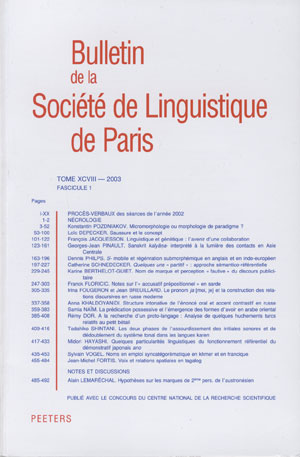 previous article in this issue previous article in this issue | next article in this issue  |

Preview first page |
Document Details : Title: Sur la construction latine ab urbe condita Author(s): ROUVERET, Alain Journal: Bulletin de la Société de Linguistique de Paris Volume: 113 Issue: 1 Date: 2018 Pages: 215-265 DOI: 10.2143/BSL.113.1.3285469 Abstract : Le présent article propose une analyse de la construction latine Ab urbe condita, également désignée, depuis les années soixante-dix, sous l’étiquette de construction à «participe dominant». Cette dernière notion, faiblement opératoire, ne joue aucun rôle dans l’approche qui est proposée ici. On montre par contre qu’une caractérisation syntaxique précise des participes passés passifs, une fois qu’on la combine avec l’idée que le groupe nominal sujet est à l’origine l’argument direct du participe, explique pourquoi le latin, langue sans article, autorise l’intégration d’une structure prédicative dans une construction typiquement nominale. Les constructions à «adjectif verbal dominant», le complément participial des verbes de perception et de représentation, les structures ablatives absolues sont également considérées. Il apparaît que si les premières admettent le même type d’analyse que les constructions à participe dominant, les secondes et les troisièmes doivent en être nettement distinguées. This paper proposes an analysis of the Latin construction Ab urbe condita, which is also currently referred to as the 'dominant participle construction'. The latter notion, which is weakly operative, plays no role in our approach. It is shown that a precise syntactic characterization of passive past participles, combined with the idea that the nominal subject is first merged as the direct argument of the participle, explains why Latin, an articleless language, allows the embedding of a predicative structure in a typically nominal construction. The 'dominant gerundive construction', the participial complement of perception and representation verbs and the ablative absolute construction are also considered. It appears that the first one can be analyzed along the same lines as the dominant participle construction, but that the other two should be sharply distinguished from it. Il presente articolo propone un’analisi della costruzione latina Ab urbe condita, anche definita, a partire dagli anni settanta, come una costruzione a 'participio dominante'. Quest’ultima nozione, poco efficace, non riveste alcun ruolo nell’approccio qui proposto. Si dimostra invece quanto la caratterizzazione sintattica precisa dei participi passati passivi, coniugata all’idea che il gruppo nominale soggetto è da principio l’argomento diretto del participio, riesca a spiegare perché il latino, lingua senza articolo, autorizzi l’inserzione di una struttura predicativa in una costruzione tipicamente nominale. Le costruzioni a 'gerundivo dominante', il complemento participiale dei verbi di percezione e di rappresentazione e le strutture ablative assolute sono ugualmente esaminate. Si evince che se le prime ammettono la stessa analisi delle costruzioni a 'participio dominante', le seconde e le terze devono invece esserne nettamente distinte. |
|


